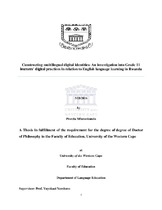| dc.description.abstract | Rwanda has taken a strong move towards language-in-education policy shift whereby English became the sole medium of instruction in 2008, despite her rich linguistic diversity. The language shift occurred at the time when the country had resolutely embraced Information Communication Technologies (ICTs) as one of the country’s key development plans for socioeconomic development. In spite of these changes, research on multilingualism and digital identity in Rwanda is very limited. Given the pressing need for Rwanda to play an increasing role in the global economy, it is important to explore the ways in which the new generation
negotiates multilingual digital identities in second language learning. The aim of this study, therefore, was to investigate the ways in which secondary school learners
used digital technologies to negotiate new identities in two or more languages in order to understand the implications for English second language learning in the multilingual context of postcolonial Rwanda. Specifically, my interest was to examine Grade 11 learners’ current digital practices and the ways in which existing multilingual repertoires were drawn on as resources in navigating digital literacies. I also aimed at understanding how such practices could be harnessed as resources for English second language learning in the classroom. This study is informed by post-structural theories of identities as well as of Bourdieu’s theory of habitus, field and capital. The post-structural frame of analysis underlying issues of Second
Language Acquisition (SLA) has also been important to establish a bridge between the learners’ digital practices and their English learning processes. It draws on debates around digital literacies, multilingualism, and identity, theories of access to ICTs and digital technologies and English as Additional Language Acquisition. The research sites were two urban based high schools mainly selected for their proximity to digital technologies, namely cyber cafes and/or computer laboratories and by their representativity in terms of gender and subject choices. Drawing on the qualitative research tradition and informed by ethnographic methodology, the study investigated Grade 11 learners’ insider views of the affordances of digital technologies for language learning. To reach this end, non-participant observations, focus group discussions and a questionnaire were used. Issues of research ethics namely, informed consent, anonymity and confidentiality were adhered to
throughout the research process. With regard to access to technologies, the research findings reflect Bourdieu’ post-structural theory notion of ‘habitus’ as they show that the social dimensions the learners were involved in influenced their engagement with several digital technologies. In relation to Warschauer’s model
of access, this study was able to identify the following: (1) material access’ linked to the learner’s access to the internet connection; (2) skills access’ concerning the learner’s ability to interact with computers and communicate with peers or fellow friends by typewriting and (3) usage access’ associated with the learner’s opportunity to use ICT facilities. The findings also generated insights into the learners’ construction of multiple digital identities and the fluidity and hybridity of ‘youth digital literacies’. The learners created a form of global digital identity by simply interacting or engaging with various multimodal literacies. Findings also indicated that learners negotiated digital identities by immersing themselves in
Social Networking Sites (SNS) that fall under ‘Web 2.0’, an online platform which online users make use of to interact, share and perform different activities, focusing chiefly on social media. It was observed further that learners constructed a national language identity in the digital world by visiting mostly popular sites whose medium of communication was the national vernacular “Kinyarwanda”, thus stimulating the sense of national language identity of ‘ Rwandaness’. Additionally, it was apparent that Grade 11 learners had a great sense of attachment to their
language as a significant characteristic of their digital practices through ‘translanguaging’ which became one of the resources in the digital space. The findings also indicate that technology served as a bridge between learners’ digital practices and their learning of English as an additional language, although language power relations were apparent as English was conferred a status of symbolic capital. The study concludes that various forms of access to ICTs do not only inform and strengthen Grade 11 learners’ process of learning English as additional language, but also support the construction of their multiple identities. There is a need to capitalize on face-to-face interaction and integrate ICT in teaching and learning so that learners can create their own learning space whereby they construct their digital identities as adolescents in the different languages they get
exposure to. | en_US |

